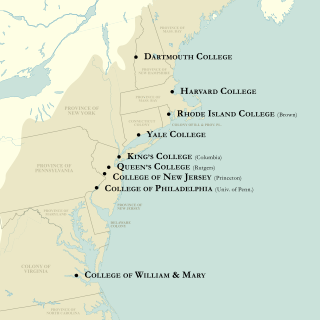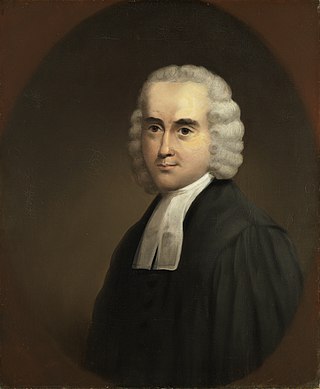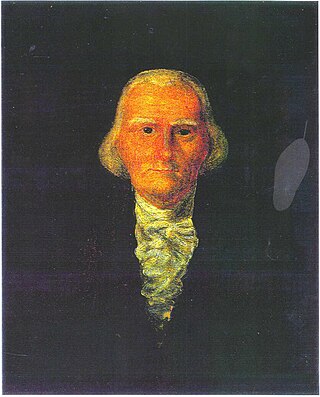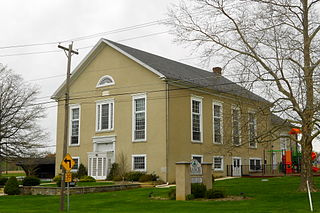
Archibald Alexander was an American Presbyterian theologian and professor at the Princeton Theological Seminary. He served for 9 years as the President of Hampden–Sydney College in Virginia and for 39 years as Princeton Theological Seminary's first professor from 1812 to 1851.

The colonial colleges are nine institutions of higher education chartered in the Thirteen Colonies before the founding of the United States of America during the American Revolution. These nine have long been considered together, notably since the survey of their origins in the 1907 The Cambridge History of English and American Literature.

Princeton Theological Seminary (PTSem), officially The Theological Seminary of the Presbyterian Church, is a private school of theology in Princeton, New Jersey. Founded in 1812 under the auspices of Archibald Alexander, the General Assembly of the Presbyterian Church (USA), and the College of New Jersey, it is the second-oldest seminary in the United States. It is also the largest of ten seminaries associated with the Presbyterian Church.

Gilbert Tennent was a Presbyterian revivalist minister in Colonial America. Born into a Scotch-Irish family in County Armagh, Ireland, he migrated to America with his parents, studied theology, and along with Jonathan Edwards and George Whitefield, became one of the leaders of the evangelical revival known as the First Great Awakening. His most famous sermon, On the Danger of an Unconverted Ministry, also known as the "Nottingham Sermon," compared "Old Side" ministers to the biblical Pharisees of the Gospels, triggering a schism in the Presbyterian Church which lasted for 17 years. A prolific writer, Tennent would later work towards reunification of the two synods involved.

The Princeton theology was a tradition of conservative Reformed and Presbyterian theology at Princeton Theological Seminary lasting from the founding of that institution in 1812 until the 1920s, after which, due to the increasing influence of theological liberalism at the school, the last Princeton theologians left to found Westminster Theological Seminary. The appellation has special reference to certain theologians, from Archibald Alexander to B. B. Warfield, and their particular blend of teaching, which together with its Old School Presbyterian Calvinist orthodoxy sought to express a warm evangelicalism and a high standard of scholarship. W. Andrew Hoffecker argues that they strove to "maintain a balance between the intellectual and affective elements in the Christian faith."

Jonathan Dickinson was a Congregational, later Presbyterian, minister, a leader in the Great Awakening of the 1730s and 1740s, and a co-founder and first president of the College of New Jersey, which later became Princeton University.

William Tennent was an early Scottish American Presbyterian minister and educator in British North America.

William Tennent High School is a public high school serving grades 9 through 12, located in Warminster, Pennsylvania, US.

Samuel Finley was an Irish-born Presbyterian minister and academic. He founded the West Nottingham Academy and was the fifth president and an original trustee of the College of New Jersey from 1761 until 1766.

James Carnahan was an American clergyman and educator who served as the ninth President of Princeton University.
James Finley was an American Presbyterian minister and politician who was a pioneer resident of Western Pennsylvania. Either he or his wife owned the house in which Thomas Jefferson began his first attempt to draft the United States Declaration of Independence.
Princeton University was founded in Elizabeth, New Jersey, in 1746 as the College of New Jersey, shortly before moving into the newly built Nassau Hall in Princeton. In 1783, for about four months Nassau Hall hosted the United States Congress, and many of the students went on to become leaders of the young republic.
John Thomson or Thompson was born in Ireland and became a minister in the Presbytery of Philadelphia, later the Synod of Philadelphia. He served as a missionary in both Virginia and North Carolina, where he died a natural death in 1753. He is buried in the cemetery of Centre Presbyterian Church in Mooresville, North Carolina.

Samuel Davies was an evangelist and Presbyterian minister. Davies ministered in Hanover County from 1748 to 1759, followed by a term as the fourth President of Princeton University, then known as the College of New Jersey, from 1759 to 1761. Davies was one of the first non-Anglican preachers in Virginia, and one of earliest missionaries to slaves in the Thirteen Colonies. He was a strong advocate for religious freedom, and helped to institute significant religious reforms in the colony. Davies was also a prolific writer, authoring several hymns and publishing a book of poetry. He advocated for providing religious education to slaves.

Samuel Miller was a Presbyterian theologian who taught at Princeton Theological Seminary.

Samuel Blair was a Presbyterian minister and one of the leaders of the Presbyterian New Light religious movement that swept the North American colonies as part of the First Great Awakening. In 1739, he founded a theology school, Faggs Manor Classical School, near his church in Faggs Manor, Pennsylvania. Blair's son, also named Samuel Blair was born in Faggs Manor, and became the second Chaplain of the United States House of Representatives. The church was rebuilt in 1846 and is now known simply as the Faggs Manor Presbyterian Church.

John Blair was a Presbyterian minister, a Trustee, Professor, and Acting President of Princeton University. His brother Samuel Blair was a leader of the Presbyterian New Light religious movement. His nephew, Samuel Blair was the second Chaplain of the United States House of Representatives.

Daniel Veech McLean was a Presbyterian minister and the fifth president of Lafayette College.

William Hallock Johnson was an American educator who served as president of the historically black Lincoln University of Pennsylvania from 1926 to 1936. He had a liberalizing effect on the institution, presiding over the appointment of its first Black faculty member, and substantially reduced the university's debt.















